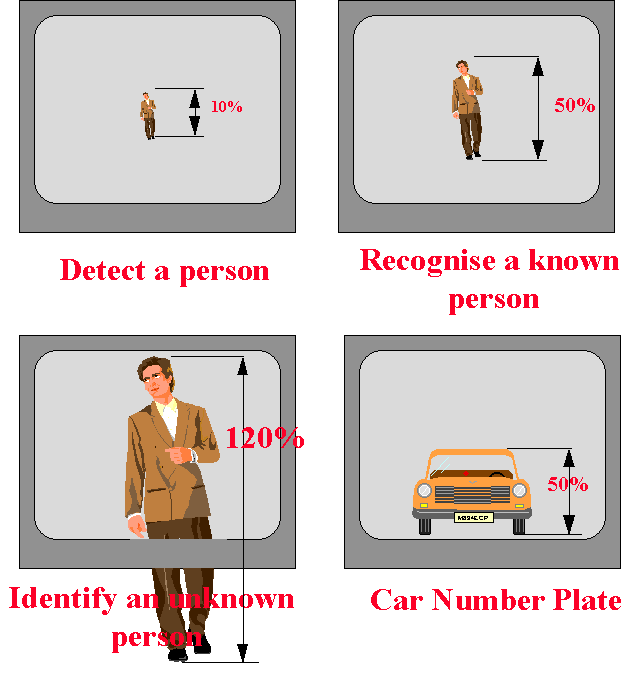>
Guidelines for IdentificationHere are some guidelines for identification of persons and vehicles. Charts showing the horizontal and vertical fields of view for many lenses and four formats are given in ‘The Principles and Practice of CCTV’ They also show the % of the screen height of a 1.7M person. The values for various degrees of identification are given as the percentage the 1.6M figure would occupy of the monitor screen. This is called the ‘screen height ratio’. This criteria can be used as part of the specification for CCTV systems, particularly in Town or city Centre schemes. Sometimes you know the distance from the camera for each situation, sometimes you know at what distances from the camera, will be the center of the action. In either case it involves calculations that are not too difficult but can be tedious to keep repeating for each lens and camera location. Another problem many people find difficulty in resolving are the different fields of view obtained from various camera and lenses formats, i.e. what is the result of fitting a 2/3" lens onto a 1/2" camera, and how does this affect the screen height ratio at certain distances? A word of caution, just about all lens manufacturers brochures give the HORIZONTAL angle of view, whereas these calculations require the VERTICAL angles of view. The vertical angle of view is the horizontal angle times 3/4.
Field of view The field of view is the ratio of the sensor size to the focal length and the distance to the subject. This is shown in diagram1. The 'width to height' ratio of the sensor is 4:3. The horizontal and vertical angles and therefore fields of view are different and must be considered separately.
Note when using these ratios all the units must be the same, i.e. millimeters or Meters. Diagram 2 shows the sensor sizes to be used when calculating fields of view and angles of view. Diagram 2 Sensor Dimensions Example Suppose it required to recognize a known person at 50M, using a 2/3" lens, the following is the calculation.
The scene height at 50M needs to be twice the standard height, 2 x 1.6=3.2M. Therefore:
The nearest standard would be a 10.5:105mm zoom lens to satisfy this requirement. The formula can be worked backwards to find the scene height for a given lens. It is a simple matter to put all these criteria into a spreadsheet program and find the result for any combination. However, this may not be very convenient for the many salespersons on the road.
Do it the easy way The following table summarizes the main three criteria for the Home Office guidelines, 10% to ‘see’ a person, 50% to recognize a known person and 120% to identify an unknown person.
The focal lengths of lenses for four camera formats is listed in the first four columns. The next column lists the vertical angle of view for each. The remaining columns list the percentage of the screen a 1.6M target would be at various distances. Using the table
For instance, a 50mm lens on a 2/3" camera would produce a ratio of 9.7% at 125M, 60.6% at 20M and 121.1% at 10M.. The scale across is linear so intermediate distances can be interpolated. In this example the 50% criteria would be met at 25M. (between 20 & 30). On the other hand a 50mm lens on a 1/2" camera would produce ratios of 11.2% at 150M, 56% at 30M and 120% at about 16M (interpolated). Note that it is the FOCAL LENGTH of the lens that is significant not the lens format. The lens format is significant in that a larger format lens can be used on a smaller format camera but not the reverse
Note that the angles of view are calculated from the sensor sizes, The actual angle may vary between manufacturers but will only have a marginal effect on the results from the table. If a precise value is required then the vertical angleof view must be taken from manufacturers data and not calculated from the sensor size. |
|
|
|||||||||||||||
| R.S.C. Broadband Supply Co. © 2006 • Privacy Policy • Terms Of Use | ||||||||||||||||






